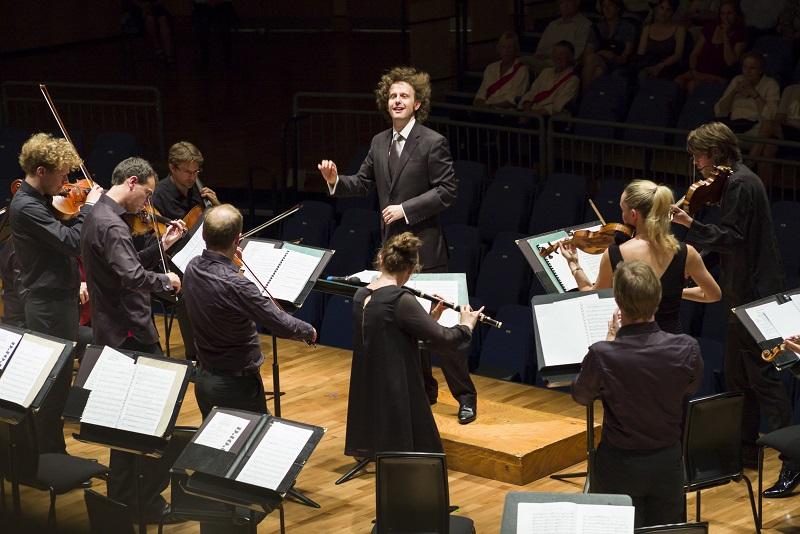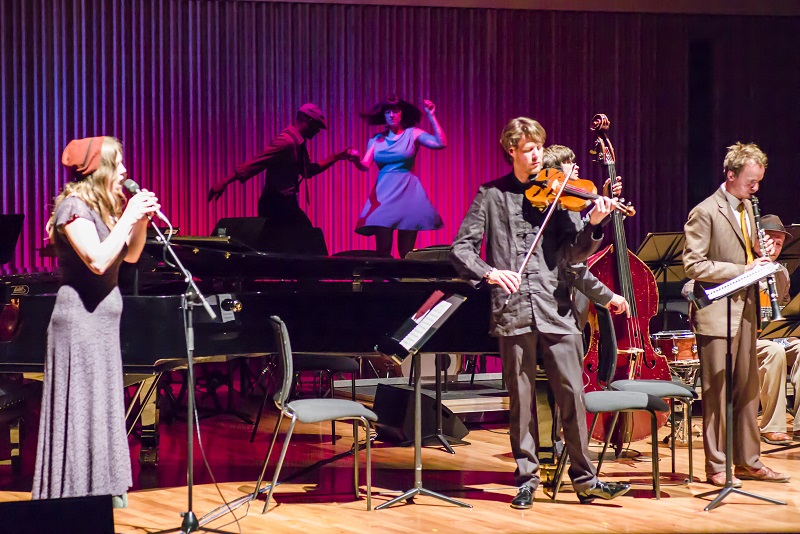Man Overboard, Aurora Orchestra, Collon, LSO St Luke's | reviews, news & interviews
Man Overboard, Aurora Orchestra, Collon, LSO St Luke's
Man Overboard, Aurora Orchestra, Collon, LSO St Luke's
London's cross-collaborating ensemble wears its USP on its sleeve

If the 15-word limit of a succinct listings blurb ever taught you a lesson let it be immediate suspicion of any performer or musician termed "jazzy". This wariness could extend to anything generically suffixed by "y" or "ish", simply because it suggests either pretence or a lack of original or strong identity.
From conductor Nicholas Collon's swift and jovial entrance onto the stage at LSO St Luke's, to the players' flamboyant swaying, the Aurora Orchestra are quite clearly a well-staged entity. Their slick showmanship, low necklines and less traditional choices of collaborators provide that crucial USP that the LPO, RPO, LSO or other acronym-bound ensembles might also consider at an audience development meeting.
Rameau was the first to be tackled in this Jitterbug-themed show, and was played with a certain gusto, modelled perhaps on the mesmerising energy of Italy's L'Aura Soave Cremona ensemble, albeit with a sheen of British modesty. Charming though its rhythmic bounce, baroque can be a tiresome affair of predictable cycles and musical ringlets, but thankfully they had anticipated a modern attention span. Following only a moment's pause their top-heavy ornamental sound broke down into a bold solo double bass line that seemed both out of place and almost credible as a radical final scherzo. It is these musical hinges that characterise the Aurora Orchestra's work, and their commitment to re-contextualising classical repertoire is welcome.
 Building now from the rhythm section and upwards via viola and harpsichord, to be joined on stage by trilby-clad "gypsy jazz"-style guitarist Jean-Marie Fagon and crew, it was clear we had apparently travelled forward a few centuries and descended into the cellar of a European wine bar. Man Overboard were to become the second feature of a transatlantic foray into the historical dance music repertoire. True to the event flyer, but somewhat incongruously, a couple of dancers from Swing Patrol floated onto a red-lit stage to accompany an arrangement of traditional standard "St James Infirmary" arranged by bassist Dave O'Brien. Meanwhile vocalist Louisa Jones clutched timidly at the microphone, retelling an age-old tale with her own subtle backstory and a tone authentically reminiscent of a husky, melancholic blues songstress.
Building now from the rhythm section and upwards via viola and harpsichord, to be joined on stage by trilby-clad "gypsy jazz"-style guitarist Jean-Marie Fagon and crew, it was clear we had apparently travelled forward a few centuries and descended into the cellar of a European wine bar. Man Overboard were to become the second feature of a transatlantic foray into the historical dance music repertoire. True to the event flyer, but somewhat incongruously, a couple of dancers from Swing Patrol floated onto a red-lit stage to accompany an arrangement of traditional standard "St James Infirmary" arranged by bassist Dave O'Brien. Meanwhile vocalist Louisa Jones clutched timidly at the microphone, retelling an age-old tale with her own subtle backstory and a tone authentically reminiscent of a husky, melancholic blues songstress.
Creative though their approach is, the missing element of the concert was something ephemeral. Nowadays we might call it groove, but for the era in question "swing" is the fad-word and, however pretty the typeface on the programme, without that indefinable crux of dance music it don't really mean a thing. The final piece, before the auditorium was transformed into a "Speakeasy" dancehall, was a rare modern arrangement of "Porgy and Bess", starring an amusingly understaffed percussion department of only one manic marimba and timpanist. Gershwin, who himself was evoking jazz, was a fitting crowd-pleaser to conclude a concert which hinted at atmospheres and themes, but was a little too "-ish" to move much more than the big toe in a distant leather sandal.
rating
Explore topics
Share this article
Add comment
The future of Arts Journalism
You can stop theartsdesk.com closing!
We urgently need financing to survive. Our fundraising drive has thus far raised £49,000 but we need to reach £100,000 or we will be forced to close. Please contribute here: https://gofund.me/c3f6033d
And if you can forward this information to anyone who might assist, we’d be grateful.

Subscribe to theartsdesk.com
Thank you for continuing to read our work on theartsdesk.com. For unlimited access to every article in its entirety, including our archive of more than 15,000 pieces, we're asking for £5 per month or £40 per year. We feel it's a very good deal, and hope you do too.
To take a subscription now simply click here.
And if you're looking for that extra gift for a friend or family member, why not treat them to a theartsdesk.com gift subscription?
more Classical music
 Kilsby, Parkes, Sinfonia of London, Wilson, Barbican review - string things zing and sing in expert hands
British masterpieces for strings plus other-worldly tenor and horn - and a muscular rarity
Kilsby, Parkes, Sinfonia of London, Wilson, Barbican review - string things zing and sing in expert hands
British masterpieces for strings plus other-worldly tenor and horn - and a muscular rarity
 From Historical to Hip-Hop, Classically Black Music Festival, Kings Place review - a cluster of impressive stars for the future
From quasi-Mozartian elegance to the gritty humour of a kitchen inspection
From Historical to Hip-Hop, Classically Black Music Festival, Kings Place review - a cluster of impressive stars for the future
From quasi-Mozartian elegance to the gritty humour of a kitchen inspection
 Shibe, LSO, Adès, Barbican review - gaudy and glorious new music alongside serene Sibelius
Adès’s passion makes persuasive case for the music he loves, both new and old
Shibe, LSO, Adès, Barbican review - gaudy and glorious new music alongside serene Sibelius
Adès’s passion makes persuasive case for the music he loves, both new and old
 Anja Mittermüller, Richard Fu, Wigmore Hall review - a glorious hall debut
The Austrian mezzo shines - at the age of 22
Anja Mittermüller, Richard Fu, Wigmore Hall review - a glorious hall debut
The Austrian mezzo shines - at the age of 22
 First Person: clarinettist Oliver Pashley on the new horizons of The Hermes Experiment's latest album
Compositions by members of this unusual quartet feature for the first time
First Person: clarinettist Oliver Pashley on the new horizons of The Hermes Experiment's latest album
Compositions by members of this unusual quartet feature for the first time
 Gesualdo Passione, Les Arts Florissants, Amala Dior Company, Barbican review - inspired collaboration excavates the music's humanity
At times it was like watching an anarchic religious procession
Gesualdo Passione, Les Arts Florissants, Amala Dior Company, Barbican review - inspired collaboration excavates the music's humanity
At times it was like watching an anarchic religious procession
 Classical CDs: Camels, concrete and cabaret
An influential American composer's 90th birthday box, plus British piano concertos and a father-and-son duo
Classical CDs: Camels, concrete and cabaret
An influential American composer's 90th birthday box, plus British piano concertos and a father-and-son duo
 Cockerham, Manchester Camerata, Sheen, Martin Harris Centre, Manchester review - re-enacting the dawn of modernism
Two UK premieres added to three miniatures from a seminal event of January 1914
Cockerham, Manchester Camerata, Sheen, Martin Harris Centre, Manchester review - re-enacting the dawn of modernism
Two UK premieres added to three miniatures from a seminal event of January 1914
 Kempf, Brno Philharmonic, Davies, Bridgewater Hall, Manchester review - European tradition meets American jazz
Bouncing Czechs enjoy their Gershwin and Brubeck alongside Janáček and Dvořák
Kempf, Brno Philharmonic, Davies, Bridgewater Hall, Manchester review - European tradition meets American jazz
Bouncing Czechs enjoy their Gershwin and Brubeck alongside Janáček and Dvořák
 Solomon, OAE, Butt, QEH review - daft Biblical whitewashing with great choruses
Even a top soprano and mezzo can’t make this Handel paean wholly convincing
Solomon, OAE, Butt, QEH review - daft Biblical whitewashing with great choruses
Even a top soprano and mezzo can’t make this Handel paean wholly convincing
 Two-Piano Gala, Kings Place review - shining constellations
London Piano Festival curators and illustrious friends entertain and enlighten
Two-Piano Gala, Kings Place review - shining constellations
London Piano Festival curators and illustrious friends entertain and enlighten
 Echo Vocal Ensemble, Latto, Union Chapel review - eclectic choral programme garlanded with dance
Beautiful singing at the heart of an imaginative and stylistically varied concert
Echo Vocal Ensemble, Latto, Union Chapel review - eclectic choral programme garlanded with dance
Beautiful singing at the heart of an imaginative and stylistically varied concert

Comments
Interesting perspective. For